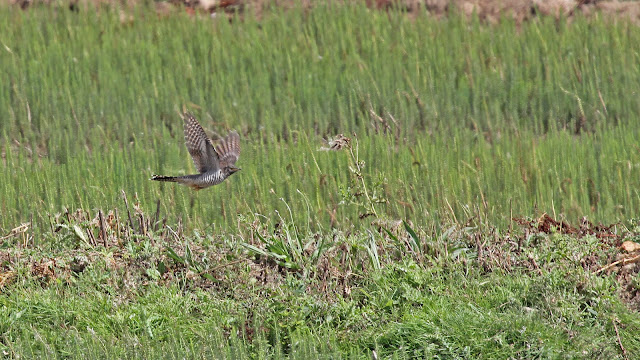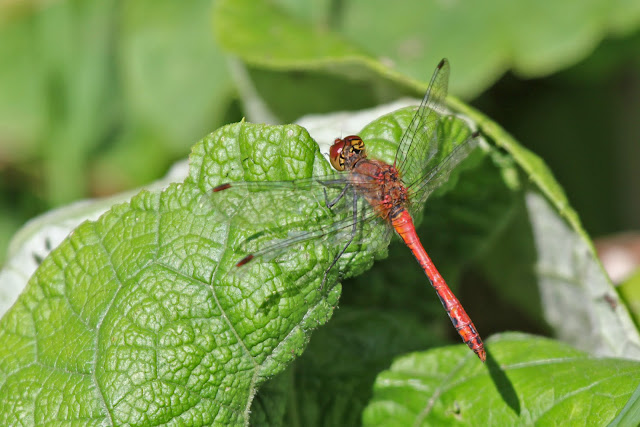Saturday morning we set off for Minsmere, the weather wasn't too bad, although showers were forecast through out the day. Our first stop was the scrape from the north hide. Compared to our visits in spring it was very quiet, there were no gulls and terns calling, and there was very little to see apart from the odd Coot and Moorhen. We made our way around to the bittern Hide. A bittern had been seen just before we arrived, and it wasn't long before one appeared from the reeds and flew across the pools in front of us and settled down in the reeds again. It stayed in view though, and we were able to watch as it it moved slowly about, pausing to stretch its neck to sky, as if trying to hide.
It stayed on show for quite awhile, then gradually made its way out of sight behind some small bushes. Bitterns put on quite a show here with at least three others being seen flying across the reeds. The only other bird of note was an immature Marsh Harrier that put in a brief appearance away off to the back of the reed bed.
We left the Bittern Hide, and walked around to the Island Mere Hide, it was at this point that one of the scattered showers came along with a vengeance. Since we were last here they have renovated the hide, pushing it further into the lake, and building a lovely open and roomy hide. I managed to find the female Ferruginous Duck at the furthest point possible from the hide. She was preening with teal, but I could see the white undertail and the distinctive head shape. Apart from that there were just the usual suspects on the water, and all was still eerily quiet.
After a cup of coffee in the refurbished visitor centre we headed off back to the scrape. In the first hide a quick scan of the pools and banks found a juvenile Cuckoo. It seemed to be hunting insects on the bank, and would every so often fly down to catch something. It was quite late to see a cuckoo, and some of the hide's watchers were concerned it might not get to Africa
On the pools at the back of the scrape (why are hey always so far from the hides?) were a Ringed Plover and five Dunlin. Feeding around the islands were also Black-tailed Godwits, showing remnants of their brick red summer plumage.
The showers had dried up, and it was very nice now with plenty of sunshine. We walked to the sluice, pausing to watch the Little Egrets feeding in the flooded area where the reeds had been cut.
Eight here was a nice sized flock, Minsmere has been having record counts over the summer with well over 50 being seen. A little further along they could be seen feeding with the Konig's Ponies in the background producing a scene not unlike that found in the Carmarque in France.
Looking across the reeds towards the sea there were some amazing cloud formations, that were probably delivering the forecast showers well out to sea.
We watched the swallows at the Sluice, using the small bushes to rest as they fed around the fields. From here we walked through the dunes, in the sunshine the sea looked a dirty tea colour, and was quite rough. Once out of the wind in the dunes, the sun was quite warm, and this was suiting the quite a few Common Blue butterflies. This one nectaring and sunning on a bramble flower.
A darker larger butterfly caught the eye, normally appearing from somewhere on the ground. I managed to get closer to one, and was able to confirm my first Grayling. This butterfly, the largest of our 'browns', is a master of disguise, although fairly conspicuous when in flight, it can mysteriously disappear as soon as it lands, perfectly camouflaged against a background of bare earth and stones, always resting with its wings closed. When it first lands, and when disturbed, the butterfly will raise its forewings for a second or so, revealing dark eye spots that stand out against the different browns.
Another find in amongst the gorse and bramble in the dunes was a very small Adder. We haven't seen one of these for some time. This individual was a red colour, but had the distinctive black markings. Unfortunately as I raised my camera the sound scared it and it slipped away into he bush.
Leaving the dunes we went into the east hide on the scrape, again most of the action was distant, there were some more dunlin, and two ringed plovers this time away to the back of the visible area. A lone Spotted Redshank did make its way around the edge of the pools, and finally out in front of the hide.
Leaving the hide we walked along the north wall, and back to the car. It was still very sunny so we decided to go up to Dunwich Cliffs for a cup of tea at the National Trust centre.
The heathland around Dunwich was covered in purple blooming heather and looked stunning in the sunshine and against the now darkening sky. As we drank our tea we watched a very spectacular storm slip to the south of us and out to sea, we could see and hear the lighting and thunder as it made its way from us.
Dark clouds were now threatening all around, but this did bring out the best in the heather. These were some of the scenes around us as we enjoyed the tea.
As we left Dunwich, the rains came so we headed back to the cottage.
In the morning it was nice and sunny once again, and we decided to drive over to the RSPB reserve at Lakenheath. There was always the chance of finding the cranes that we had seen last year.
In the car park the gorse bushes wee a big attraction to Red Admirals, with several being found sunning themselves on the bark.
On the path to the visitor centre Helen found a very nice Small Copper, the first strangely for the year.
As we set off along the trail we noticed two main things, there were many dragonflies flying around the reeds, and we were constantly walking through spiders webs, and having to wipe the silk from our faces.
The reeds look wonderful at the moment, with the aubergine colour of the flower heads contrasting with the olive green of the leaves and stems.
Every so often one of the dragonflies would stop to rest, either on the ground or on a tree leaf. This allowed the opportunity to photograph them. These are the common Darter. The male is red with dark patches on the tips of the wings
The female is a yellow ochre colour.
We stopped at the first watchpoint to view the area of water, and were rewarded as a Kingfisher flashed by and out over the water. It paused to hover before dropping and disappearing into the many channels in the reed bed. We waited but it didn't return, so we continued the walk to the next watchpoint.
As we made our way along the footpath two Hobbies could be seen over the reed bed beyond the railways. They drifted towards us but gained height and never gave the opportunity for a photograph. At the watchpoint we sat and enjoyed both the sunshine and the view. Just to prove how abundant the dragonflies were, and individual even made it into this view across the reeds.
As we sat and watched a Marsh Harrier made a distant appearance, and another hobby zipped through. When we were here in May last year the sky was just full of hobbies, with over 50 being counted.
We walked back along the bank of the the dyke alongside the River Ouse. It was quiet on both sides, with three Great-crested Grebes on the river with swans and a single Little Egret, and very little but wood pigeons over the reeds on the reserve. Back in the car park, a very nice small tortoiseshell was feeding on the flowers.
Rather than take the direct route back to the cottage we went through the countryside in the hope that maybe we might find something of interest. In previous years we have seen Barn Owls, and that was the hope today. We were almost back at the cottage when Helen called out to stop. I had to reverse the car to find what she had seen, it was a Little Owl in a dead tree, it was remarkable she had seen it but it allowed me to photograph it. It was very alert, and flew from one tree to the other.
A very nice end to the day, and to the short break. It may not have been as prolific as the spring visits, but was it was still a very enjoyable weekend.


























No comments:
Post a Comment